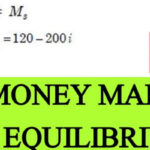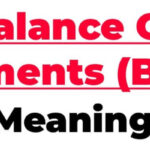Crossing a cheque is an important concept in banking and finance. It is a common practice for banks and other financial institutions to cross cheques before they are presented for payment.
The crossing of a cheque serves as a security measure to help reduce the risk of fraud and to ensure that the cheque is paid only to the intended recipient.
In this post, we will discuss crossing a cheque and different types of crossing of cheques that exist.
Table of Contents
ToggleWhat is Crossing of Cheque
Crossing of cheque is an instruction given to the bank by the drawer of the cheque to the effect that the cheque should be paid only through a bank account.
See Also: Advantages and Disadvantages of Cheques
The cheque should not be encashed by the payee. Crossing of a cheque is done by writing two parallel lines across its face with or without the words ‘not negotiable’.
It serves as a security measure against unauthorized use and fraudulent manipulation of the cheque.
Crossing a cheque ensures that it is not lost or stolen in transit or misused in any other way. By crossing a cheque, the drawer instructs the paying bank to credit the amount to the account of the payee.
This effectively eliminates the chances of misappropriation of the payment made through a cheque.
Types of Crossing of Cheques
Crossing of a cheque is a process of marking two parallel lines on the face of a cheque with or without mentioning a bank name between them.
This is done to protect the cheque from being misused. Crossing helps in protecting the interest of the payee of the cheque and makes sure that the amount mentioned in the cheque is transferred only to the account of the intended payee.
There are several types of crossing, each having its own set of rules and regulations. Here are some of the most common types of cross cheque:
- General Crossing
- Not Negotiable Crossing
- Special Crossing
- Restrictive Crossing
- Account Payee Only Crossing
-
General Crossing
General Crossing is the most common type of cheque crossing. Under this method, two parallel lines are drawn on the face of the cheque with or without the words “and company” written between them.
Generally, these words are not written between the lines. This form of crossing indicates that the cheque can only be deposited in an account in a bank or some other specified institution.
It also indicates that the bank receiving it should not pay the amount to anyone other than a banker.
In general crossing, the payee is not specified and the cheque can be cashed by anyone who possesses it.
-
Special Crossing
Special Crossing is a type of crossing that is done when the payee or the holder of the cheque is directed to deposit the cheque in a specific bank account only.
The bank will not honor the cheque if it is deposited in any other bank account. This type of crossing is done by marking ‘account payee only’ across the face of the cheque.
See Also: What is a Promissory Note
Special Crossing of cheques gives extra security to the payee and the holder of the cheque. Fraud and money laundering are also at a lower risk as a result.
-
Not Negotiable Crossing
The non-negotiable crossing is a type of crossing in which the payee does not acquire the right to negotiate the cheque further.
When such a crossing is made on a cheque, the words ‘Not Negotiable’ are written on the face of the cheque.
The non-negotiable crossing is generally used when the cheque is meant to be deposited in a bank and not paid to anyone else.
The payee of the cheque can deposit it only in his account in the same bank in which the cheque is drawn.
This type of crossing is also useful for protecting the interests of the parties involved, especially if the cheque is lost or stolen.
In case of a non-negotiable crossing, the person who holds the cheque does not have any authority to collect the payment from the bank.
-
Account Payee only Crossing
Account payee-only crossing is a type of crossing of cheques that is primarily used to ensure that the amount mentioned on the cheque goes directly to the right account.
In this type of crossing, the words ‘Account Payee Only’ is written across the face of the cheque and the signature of the issuing bank is made underneath it.
This type of crossing is particularly used when the cheque is issued for the payment to a particular individual or organization.
The main purpose of Account Payee Only crossing is to prevent the money from being misused in any way. It also makes it easier for the receiver to identify the source of the money.
See Also: What is Money | Functions of Money | Importance of Money
This type of crossing also helps in safeguarding against forgery, as it becomes more difficult for a person to duplicate the signature of the issuing bank.
In Account Payee Only crossing, the payee can either deposit or transfer the cheque directly into his or her bank account.
The receiver of the cheque cannot legally cash the cheque and must instead deposit it into an account. If they decide to transfer it, they can do so with their own bank’s help.
However, in some cases, if both the parties involved have mutual agreement and trust in each other, then Account Payee Only crossing can be relaxed for certain purposes.
This type of crossing is highly useful for those who need to receive payments from different sources and don’t want to worry about their money going anywhere else.
It helps in providing an extra layer of security and helps keep track of all transactions easily.
-
Restrictive Crossing
The restrictive crossing is a type of cheque crossing where the payment of the cheque is made only to the particular person mentioned on it.
The transferability of the cheque is restricted to the particular person and is not allowed for any other individual.
Restrictive crossing acts as an additional layer of security for the beneficiary as the payment is only made to him/her.
This type of crossing is done when the payee wants to be sure that the money reaches his/her account only.
The restrictive crossing also helps in preventing fraud or other misappropriation of funds.
The restrictive crossing can be done by marking ‘not negotiable’ above the signature of the payer on the cheque.
Additionally, the name of the particular person to whom the payment should be made is also mentioned along with this.
For instance, ‘payable only to ABC’ or ‘not negotiable – ABC’. Restrictive crossing is usually used when the payment is made to an employee, for repayment of loans, or any other specific purpose.
Conclusion
Crossing cheques is a means of securing payment from an individual or business. This method of payment is common in banking and financial transactions.
See Also: Difference between Promissory Note and Bill of Exchange
There are various types of crossings available, each offering a different level of security depending on the specific needs of the payer.
It is important to understand the differences between these types of crossings and the implications they can have when it comes to payment processing.
Understanding the crossing of cheques can help you make sure that your payment is secure and that it goes through without any complications.










